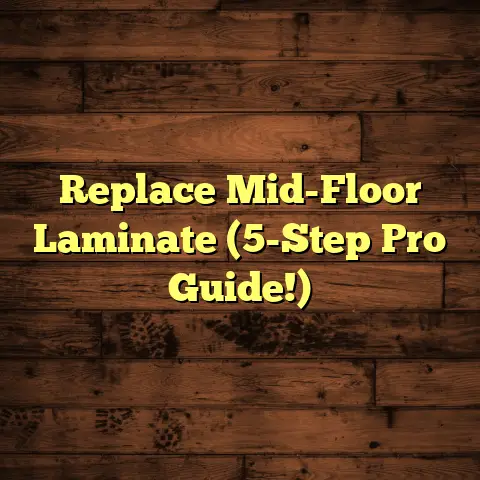Flooring a 10×12 Room: Costly Oversights? (2 Traps!)
These mistakes can not only drain your wallet, but also compromise the comfort and longevity of your new floor. So, let’s dive in and make sure you dodge these costly bullets!
Introduction: Highlighting Comfort in Flooring Choices
Flooring isn’t just about aesthetics; it’s about feel. Think about it: the first thing your feet touch in the morning sets the tone for your day.
A cold, hard tile floor in a bedroom? Not exactly a cozy start, right?
I remember one client, Sarah, who insisted on polished concrete throughout her entire house. Looked amazing in photos, but after a month, she was calling me back, complaining about how cold and echoey her living room felt.
We ended up adding area rugs and strategically placed furniture to absorb the sound and warm up the space.
The lesson? Comfort is king (or queen!) and the right flooring choice can make all the difference.
It impacts warmth underfoot, sound insulation (especially important in apartments or homes with kids!), and how easy it is to keep clean.
Section 1: Understanding the Space and Its Usage
A 10×12 room isn’t huge, but it’s versatile. It could be a bedroom, a home office, a playroom, or even a small living room.
Think about how you’ll actually use the space.
- Bedroom: Comfort is paramount. You want something soft, warm, and inviting.
- Home Office: Durability and ease of cleaning are key, especially if you have a rolling chair.
- Playroom: Stain resistance and impact absorption are crucial.
- Living Room: A balance of style, comfort, and durability is needed.
For example, if it’s a bedroom, you might prioritize carpet for its softness and warmth. But for a playroom? Vinyl or laminate might be a better bet because they’re easier to clean up spills.
Foot traffic matters too. A high-traffic area needs a more durable flooring option than a guest bedroom that’s rarely used.
Section 2: Overview of Flooring Options
Let’s run through some popular choices for a 10×12 room:
- Carpet: The classic choice for comfort and warmth, especially in bedrooms.
- Pros: Soft, warm, absorbs sound.
- Cons: Can stain easily, requires regular cleaning, not ideal for allergy sufferers.
- Cost: \$2-\$8 per square foot installed.
- Vinyl: A budget-friendly and waterproof option, great for playrooms or bathrooms.
- Pros: Affordable, waterproof, easy to clean, comes in many styles.
- Cons: Can look cheap, not as durable as some other options.
- Cost: \$3-\$7 per square foot installed.
- Laminate: Resembles hardwood but is more affordable and durable, a good choice for living rooms or offices.
- Pros: Durable, scratch-resistant, easy to install, looks like hardwood.
- Cons: Can be noisy, not waterproof (water resistant), can feel cold.
- Cost: \$3-\$11 per square foot installed.
- Hardwood: Timeless and beautiful, adds value to your home, best suited for living rooms or dining rooms.
- Pros: Beautiful, durable, adds value, long-lasting.
- Cons: Expensive, requires maintenance, susceptible to scratches and water damage.
- Cost: \$8-\$25 per square foot installed.
- Tile: Versatile and easy to clean, ideal for bathrooms or kitchens, but can work in other rooms with proper rugs.
- Pros: Durable, waterproof, easy to clean, many styles available.
- Cons: Can be cold, hard underfoot, can be slippery when wet.
- Cost: \$5-\$20 per square foot installed.
Pro Tip: Don’t just look at the upfront cost. Consider the long-term value. Hardwood, for example, might cost more initially, but it can last for decades and increase your home’s value.
Section 3: The Importance of Accurate Measurements and Budgeting
Okay, here’s trap number one: poor measurements.
I can’t tell you how many times I’ve seen homeowners underestimate the amount of flooring they need.
They measure once, maybe twice, and think they’ve got it covered. Then, halfway through the project, they realize they’re short a few boxes!
This leads to delays, extra trips to the store (which might not have the same dye lot!), and potentially wasted material if you have to buy a whole extra box for just a few pieces.
A 10×12 room is 120 square feet, right? Not so fast!
You need to factor in waste. With any flooring project, you’ll have cuts, scraps, and damaged pieces.
I generally recommend adding at least 10% to your square footage calculation to account for waste. For complex layouts or diagonal installations, bump that up to 15% or even 20%.
Example:
- Room size: 10ft x 12ft = 120 sq ft
- Waste factor (10%): 120 sq ft x 0.10 = 12 sq ft
- Total flooring needed: 120 sq ft + 12 sq ft = 132 sq ft
Pro Tip: Always measure the room in multiple places. Walls aren’t always perfectly straight, and you might find slight variations in dimensions.
Also, consider the layout of furniture and other features in the room. Are there any built-in cabinets or awkward corners that will require extra cuts?
Miscalculations impact your budget in several ways:
- Insufficient Materials: You’ll have to make another purchase, potentially at a higher price or with a different dye lot.
- Costly Overages: Buying too much and having leftover material that you can’t return.
- Increased Labor Costs: If you’re hiring a professional, delays due to insufficient materials can increase labor costs.
Section 4: Choosing the Right Underlayment
Now, let’s talk about trap number two: neglecting underlayment.
Underlayment is the material that goes between your subfloor and your finished flooring. It’s often overlooked, but it plays a crucial role in comfort, sound insulation, and the longevity of your floor.
Think of it as the unsung hero of your flooring project.
Different types of underlayment include:
- Foam: Affordable and provides basic cushioning and sound insulation.
- Cork: Natural, eco-friendly, and offers excellent sound and thermal insulation.
- Rubber: Provides superior sound and impact absorption, ideal for playrooms or apartments.
The right underlayment can:
- Improve Comfort: Adds cushioning and makes the floor feel softer underfoot.
- Reduce Noise: Absorbs sound and reduces noise transmission between floors.
- Protect Your Flooring: Provides a smooth, even surface for the flooring to rest on, preventing warping and excessive wear.
- Insulate: Adds a layer of insulation, keeping your floors warmer in the winter.
- Manage Moisture: Some underlayments have a moisture barrier to protect against moisture damage.
Example: I once had a client who installed beautiful hardwood floors without any underlayment. Within a year, the floors started to warp and buckle because the subfloor wasn’t perfectly level and there was no moisture barrier. They ended up having to replace the entire floor!
Pro Tip: Check the manufacturer’s recommendations for underlayment. Some flooring types require specific types of underlayment to maintain the warranty.
Here’s a table summarizing underlayment types and their suitability:
| Underlayment Type | Material | Thickness (Approx.) | Pros | Cons | Best For |
|---|---|---|---|---|---|
| Foam | Polyethylene, etc. | 2-6 mm | Affordable, basic cushioning, some sound insulation. | Not as durable as other options, minimal moisture protection. | Carpet, laminate (check manufacturer’s recommendation). |
| Cork | Natural cork | 2-12 mm | Eco-friendly, excellent sound and thermal insulation, moisture resistant. | More expensive than foam, can be too soft for some flooring. | Hardwood, laminate, tile (with appropriate thickness and density). |
| Rubber | Recycled rubber | 3-12 mm | Superior sound and impact absorption, durable, moisture resistant. | Can be expensive, may have a rubber odor initially. | Playrooms, apartments, areas requiring high sound insulation. |
| Combination | Various materials | 2-10 mm | Combines features of different materials (e.g., moisture barrier + foam). | Can be more expensive than single-material underlayments. | Vinyl, laminate, engineered wood (check manufacturer’s recommendation). |
Data is approximate and can vary by brand and product.
Section 5: The Hidden Costs of Installation
DIY flooring projects can seem like a great way to save money, but don’t forget about the hidden costs.
- Labor: If you’re doing it yourself, your time is valuable! How much is your weekend worth?
- Tools: You might need to buy or rent specialized tools like a flooring cutter, tapping block, or moisture meter.
- Additional Materials: Don’t forget about things like adhesive, transition strips, baseboards, and shoe molding.
- Waste Disposal: Getting rid of old flooring and scraps can cost money.
DIY vs. Professional:
- DIY:
- Pros: Saves money on labor costs.
- Cons: Time-consuming, requires skill and patience, potential for mistakes, may void warranties.
- Professional:
- Pros: Faster, higher quality installation, ensures warranty coverage, less stress for you.
- Cons: More expensive than DIY.
I always tell my clients, if you’re not comfortable with basic carpentry skills and don’t have the time or patience to do it right, hire a professional. It’s often worth the investment in the long run.
Pro Tip: Get multiple quotes from different contractors before hiring someone. Ask for references and check online reviews.
Section 6: Long-Term Maintenance Considerations
Different flooring types require different levels of maintenance. Some are more forgiving than others.
- Carpet: Requires regular vacuuming and professional cleaning to prevent staining and odor buildup.
- Vinyl: Easy to clean with a damp mop, but can be susceptible to scratches.
- Laminate: Also easy to clean with a damp mop, but avoid excessive moisture.
- Hardwood: Requires regular sweeping or vacuuming and occasional polishing. Avoid wet mopping.
- Tile: Easy to clean with a damp mop, but grout can stain over time.
Here’s a table summarizing maintenance routines:
| Flooring Type | Routine Maintenance | Periodic Maintenance | Considerations |
|---|---|---|---|
| Carpet | Vacuum 2-3 times per week. Spot clean spills immediately. | Professional deep cleaning every 12-18 months. | Use a vacuum with a HEPA filter. Consider stain-resistant treatments. |
| Vinyl | Sweep or vacuum regularly. Damp mop with mild detergent. | Apply a vinyl floor polish or restorer every 6-12 months. | Avoid abrasive cleaners. Use floor protectors under furniture legs. |
| Laminate | Sweep or vacuum regularly. Damp mop with laminate cleaner. | Avoid excessive water. Use a laminate floor cleaner. | Never steam mop laminate. Use felt pads under furniture. |
| Hardwood | Sweep or vacuum regularly. | Apply a hardwood floor cleaner and polish every few months. | Avoid wet mopping. Use mats at entrances. Consider refinishing every 7-10 years depending on wear. |
| Tile | Sweep or vacuum regularly. Mop with tile cleaner. | Seal grout every 1-2 years. | Clean spills immediately to prevent staining. Use grout cleaner for stubborn stains. |
Data is approximate and can vary by brand and product.
Pro Tip: Invest in quality cleaning products specifically designed for your flooring type. Avoid using harsh chemicals that can damage the finish.
Conclusion: Reflecting on Comfort and Oversights
So, there you have it: the two biggest traps to avoid when flooring a 10×12 room.
- Inaccurate Measurements: Measure twice, cut once!
- Neglecting Underlayment: Don’t skimp on this essential component.
Remember, flooring is an investment, not just an expense. By thinking critically about your needs, choosing the right materials, and avoiding these common oversights, you can create a comfortable and beautiful space that you’ll enjoy for years to come.
Don’t underestimate the power of a well-chosen floor to transform a room. It’s about more than just looks; it’s about how the space feels. And that feeling is priceless.





